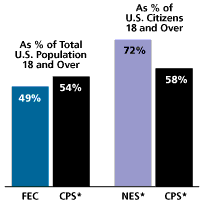
Sources of Voting Data
(October 2000) An ancient Indian fable tells of six blind men who, one by one, touch an elephant, surmise what it looks like based on what they feel, and come up with six different “big pictures,” none resembling an elephant. Researchers trying to interpret voting data for the United States encounter similar difficulties: The data come from a variety of sources, each with its own strengths and weaknesses, and they don’t always agree.
Voting in the U.S. Presidential Election, 1996

*Civilian noninstitutional population only.
Sources: Federal Election Commission; U.S. Census Bureau, Current Population Report, 1996; National Election Studies, The NES Guide to Public Opinion and Electoral Behavior, 1996.
The Federal Election Commission (FEC) obtains data on voter turnout for primaries and general elections for all federal offices, but not demographic or attitudinal data.
The U.S. Census Bureau asks questions on voting and registration in its November Current Population Survey (CPS). The CPS asks nonvoters why they didn’t vote and asks questions about region, race, Hispanic origin, sex, age, income, education level, and employment status.
National Election Studies (NES), from the Center for Political Studies at the University of Michigan, employ surveys that ask questions on region, race, sex, age, income, education level, employment status, union membership, party affiliation, and ideology. The surveys also yield information on voters’ perceptions about parties, partisanship, political values, and trust in government.
The Voter News Service collects data on voters as they are leaving the polls. The data provide an immediate snapshot of attitudes, opinions, and choices of different groups of voters.
The General Social Survey from the National Opinion Research Center at the University of Chicago produces information on frequency of voting, ideology, partisanship, and voting behavior in past presidential elections. The biennial survey is conducted before an election takes place, with questions pertaining to the previous presidential election.
Official numbers of votes cast frequently disagree with the number of people who claim in surveys to have registered and voted (see figure above). The numbers differ because of differences in how data are collected (whether surveys include a pre-election interview, as the NES surveys do) and in the populations sampled (including noncitizens, in the case of FEC data). Numbers also differ because of respondents’ tendency to overreport (say they voted when they didn’t). Also, FEC data refer to those who voted for the president in 1996, whereas the CPS and NES data in the chart refer to those who voted in the 1996 presidential and congressional election.
For More Information
Sources of Voting Data
The Federal Election Commission www.fec.gov
This site contains data on national and state voter registration and turnout in the presidential and congressional elections for 1960 through 1998. The data come from state election offices and the Congressional Research Service. The site also has some U.S. Census Bureau data for age, gender, and race/ethnicity for 1972 through 1996. These data are typically available in March of the year following an election.
U.S. Census Bureau www.census.gov/population/www/socdemo/voting.html
The Census Bureau’s website contains downloadable copies of recent Current Population Reports and detailed tables for presidential and congressional election year survey results. It also has historical information dating back to 1964, as well as some projections of the voting-age population for the nation and for states by age, race, Hispanic origin, and gender. Results have customarily been published 20 months after the November survey.
National Election Studies http://www.electionstudies.org
National Election Studies NES time-series data from 1948 to 1998 are available on CD-ROM or can be downloaded from the NES website into a statistical program. The site also contains a description, an overview, reports, technical papers, and a bibliography of papers that contain NES data. Data are typically available between February and April of the year following an election.
General Social Survey http://www.icpsr.umich.edu/icpsrweb/ICPSR/series/00028
General Social Survey GSS data from survey years 1972 to 1996 are available on the Web; data from survey years up to 1998 are on CD-ROM. This website also contains a description, list of variables, codebook, and list of publications. Users do not need to be members of the Inter-university Consortium for Political and Social Research ICPSR-see below to obtain GSS data. The 2000 GSS, which includes questions about the 1996 presidential election, will be available on the Web around mid-2001.
Inter-University Consortium for Political and Social Research www.icpsr.umich.edu
From this site, all users can download abstracts of certain studies, but data files are for members only. Included are various studies, such as the Current Population Surveys CPS, NES, VNS, and GSS. Note that the GSS data are free to nonmembers.
New York Times Poll www.nytimes.com/library/politics/elect-port.html
This site contains a report that outlines and tabulates the results of news services’ exit polls for presidential elections from 1972 to1996. These are national data by various demographic variables: age, economic status, level of education, gender, geography, marital status, political ideology, race, religion, and voting status.
